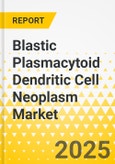This report comes with 10% free customization, enabling you to add data that meets your specific business needs.
Blastic plasmacytoid dendritic cell neoplasm is classified as a distinct entity in the World Health Organization (WHO) classification of hematolymphoid tumors, underscoring its clinical significance and need for dedicated therapeutic strategies.
The key drivers propelling the blastic plasmacytoid dendritic cell neoplasm market includes high unmet clinical need in a rare disease segment, first-in-class drug approval driving market recognition, and regulatory and reimbursement leverage through orphan designation. Blastic plasmacytoid dendritic cell neoplasm is an ultra-rare, aggressive hematologic malignancy with limited treatment options, poor prognosis, and high relapse rates making it a high-priority indication for orphan drug development. Its complex pathology, involving the CD123-positive plasmacytoid dendritic cell lineage, positions it as a biologically distinct disease, thus justifying targeted therapeutic approaches. Until recently, treatment regimens for blastic plasmacytoid dendritic cell neoplasm were largely off-label, borrowed from leukemia or lymphoma protocols with low disease-specific efficacy and high toxicity.
In addition, blastic plasmacytoid dendritic cell neoplasm qualifies for orphan drug designation (ODD) and rare pediatric disease priority review vouchers, making it strategically attractive for biotech companies. These incentives reduce development risk and time-to-market while enhancing commercial viability through market exclusivity (7 years in the U.S., 10 years in the EU).
Despite its distinct pathology, blastic plasmacytoid dendritic cell neoplasm remains severely underdiagnosed, often mistaken for leukemia, lymphoma, or cutaneous T-cell lymphoma due to overlapping presentations. The rarity poses challenges for both clinical trial enrollment and broad commercial scaling. Recruitment for Phase 3 studies in blastic plasmacytoid dendritic cell neoplasm is extremely slow. Even in leading academic centers, patient throughput is limited, which delays trial progression and data generation for new therapies of blastic plasmacytoid dendritic cell neoplasm.
One of the most promising opportunities in the blastic plasmacytoid dendritic cell neoplasm market lies in the continued innovation around CD123-targeted therapies. CD123 remains the most clinically validated and disease-specific biomarker in blastic plasmacytoid dendritic cell neoplasm, making it a strategic focal point for therapeutic development. Emerging drug classes such as antibody-drug conjugates (ADCs), CAR-T cell therapies, and bispecific T-cell engagers are being designed to enhance targeting precision, minimize systemic toxicity, and overcome resistance seen in existing treatments of blastic plasmacytoid dendritic cell neoplasm.
Another significant opportunity is the expansion into pediatric blastic plasmacytoid dendritic cell neoplasm market, which remains largely untapped. While pediatric blastic plasmacytoid dendritic cell neoplasm cases are rare, they qualify for rare pediatric disease designations, which provide developers access to priority review vouchers highly valuable assets that can be used or sold. At the same time, global regulatory approvals are broadening access. This global expansion pathway opens new commercial channels, especially in high-value markets such as Japan and Germany, and presents a viable model for emerging entrants.
Furthermore, the integration of companion diagnostics and biomarker-driven strategies is becoming increasingly important. Companion diagnostics to assess CD123 expression are being developed in parallel with therapeutics to refine patient selection, predict response rates, and optimize trial design. This approach supports not only precision medicine but also accelerates regulatory approval timelines and real-world evidence generation.
The competitive landscape of the blastic plasmacytoid dendritic cell neoplasm market is defined by a combination of first-mover advantage, orphan drug exclusivity, and emerging innovation around CD123-targeted therapies. As a result, competition is intensifying among biotech firms focused on rare hematologic malignancies, with a pipeline increasingly dominated by CD123-directed approaches and next-generation immunotherapies.
This product will be updated with the latest data at the time of order. Consequently, dispatch time for this product will be 7-10 business days.
Table of Contents
Companies Mentioned
- The Menarini Group (Stemline Therapeutics)
- Mustang Bio
- AbbVie (ImmunoGen)
- Jazz Pharmaceuticals








